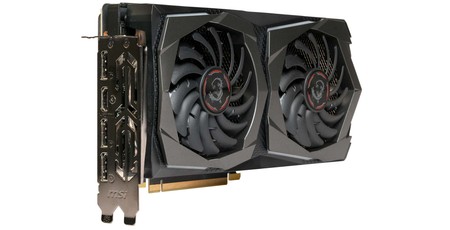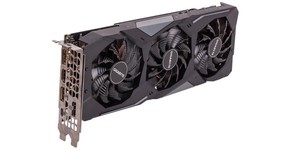Manufacturer: MSI
UK price (as reviewed): £429.99 (inc. VAT)
US price (as reviewed): MSRP $TBC
While we reviewed the Nvidia RTX 2060 Super and RTX 2070 Super Founders Edition cards a week ago, today is the actual on-shelf launch of those cards as well as the custom SKUs from add-in board (AIB) partners, reviews for which are now also released from embargo. RTX 2080 Super, meanwhile, is currently penned in for July 23rd.
A big change since last week, of course, is AMD having launched its first two Navi cards, the Radeon RX 5700 XT and Radeon RX 5700, which compete directly with RTX 2060 and RTX 2060 Super on price. Public opinion seems to agree that 3rd Gen Ryzen was an altogether much more successful launch for AMD, and this is also our stance, but both Navi cards deliver strong bang for buck and have shaken up GPU pricing in a good way. The drawback is that, true to form, the reference cooler design is a letdown when it comes to thermals and noise. This could well push buyers who are keen to upgrade imminently towards Nvidia hardware, although our recommendation is to wait until custom Navi SKUs arrive; if AIBs can give Navi the cooling it deserves while staying close to AMD’s competitive pricing, Nvidia will have a tough fight on its hands in the £300-£450 arena.
Navi aside, Nvidia’s decision to launch new SKUs instead of price-dropping existing parts allows its own AIBs to reboot their marketing machines and for Nvidia to steal some thunder throughout July as the world awaits custom Navi designs. However, AIBs have it pretty rough for RTX 2060 Super. More basic cards that target the MSRP of $399/£380 will struggle to offer much that the Founders Edition doesn’t already, while those that offer superior cooling, clock speeds, and features are likely to have go well above MSRP and thus compromise the already weak value for money against RX 5700 XT’s performance. Finding a balance of these two extremes will be tough, and we’re intrigued to see how the partners manage it.

Never one to be deterred, MSI has sent us its RTX 2060 Super Gaming X, a card based almost exactly on the RTX 2060 Gaming Z. This copycat approach is hardly surprising for a mid-cycle refresh, especially as RTX 2060 Super and RTX 2070 Super use existing GPUs just with different configurations i.e. a straight swap job in the manufacturing process is all that’s really needed. It’s therefore the approach we’re expecting most partners to take.
Given that RTX 2060 Super is based on a 175W TU106 configuration that is much closer to the RTX 2070, MSI’s choice to base its design on an RTX 2060 part initially seems strange. PCBs and coolers are primarily designed around power limitations, so we were expecting RTX 2060 Super designs to be based on the higher-end part, especially as performance-wise the new card is effectively at RTX 2070 levels. The table below sheds some light on the choice, though. With MSI sticking to reference TDP here, it should be well within the spec of what this smaller cooler can handle.
| Reference Boost Clock | Reference TDP | Gaming X Boost | Gaming X TDP | Gaming Z Boost | Gaming Z TDP | |
|---|---|---|---|---|---|---|
| RTX 2060 | 1,680MHz | 160W | N/A | N/A | 1,830MHz (+9%) | 190W (+19%) |
| RTX 2060 Super | 1,650MHz | 175W | 1,695MHz (+3%) | 175W (+0%) | N/A | N/A |
| RTX 2070 | 1,620MHz | 175W | 1,710MHz (+6%) | 225W (+29%) | 1,830MHz (+13%) | 225W (+29%) |
The downside is that the 175W limit clearly affects what MSI can do with its factory overclock. This card ships with a 1,695MHz boost clock, just 45MHz more than the reference specification – less than three percent. There’s also no memory overclock, with the out-of-box speed locked to 14Gbps. That’s pretty disappointing for a flagship unit.
You do have the option to extend this to 1,710MHz boost and 14.3Gbps memory speed via the built-in OC Mode, but you need to use the Dragon Centre software to activate it, and this overclock stops being active when the software closes. This technique is common but nonsensical; why not just ship the card in OC Mode to begin with, especially as it doesn’t increase the power limit? It’s a small difference, sure, but we’d much rather have higher clocks out of the box than a token Go Faster button that requires always-on software. For what it’s worth, there’s also a Go Slower button Silent Mode option that cuts clocks to 1,395MHz base and 1,620MHz boost i.e. slightly lower than reference. This still has no impact on the power limit, however.

The real question, however, is why stick to a 175W limit this time around? From what we’ve been able to glean from the various partners in the run-up to launch, MSI is not alone in having a modest overclock on a high-end part (Zotac’s Amp Extreme is listed with 1,710MHz at the time of writing), so we were starting to believe that RTX 2060 Super is just a poor overclocker, but this makes little sense given that the manufacturing process is now more mature, and we know older TU106 dies can be pushed hard with enough power.
We then discovered that key competitors like Gigabyte and Asus are absolutely shipping cards with much higher boost clocks – up to 1,860MHz, in fact. Interestingly, with RTX 2060 Super we may see significant divergence between the partners’ offerings based on whether they build RTX 2060 Super into an existing, power-limited RTX 2060 design or a less power-frugal RTX 2070 design. MSI has run with the former option, even for its flagship, and this is a choice that could seriously hurt its standing in performance metrics.
| Nvidia RTX 2060 Super Founders Edition | MSI RTX 2060 Super Gaming X | |
|---|---|---|
| Base Clock | 1,470MHz | 1,470MHz |
| Boost Clock | 1,650MHz | 1,695MHz (+3%) |
| OC Mode (S/W) | N/A | 1,710MHz (+4%) |
| Memory Data Rate | 14Gbps | 14Gbps (+0%) |
| OC Mode MDR | N/A | 14.3Gbps (+2%) |
| TDP | 175W | 175W |
| Power Connectors | 1x 8-pin | 1x 8-pin |
| Display Connectors | 2x DP, 1x HDMI, 1x DVI-D, 1x USB-C VL | 3x DP, 1x HDMI |
| Length | 229mm | 248mm |
| Height | 115mm | 128mm |
| Slots | 2 | 3 |
| Power Phases | 6+2 | 6+2 |
| RGB | No | Yes |
| Zero RPM Mode | No | Yes |
Coming back to the card in question, a single eight-pin PCIe plug matches the Founders Edition and is more than sufficient for the 175W TDP. Technically, there’s enough power between this and the PCIe slot for 225W, but the card has a maximum power limit of 105.7 percent, or roughly 185W. The RTX 2060 Gaming Z, meanwhile, could be extended to ~200W with the same PCB and cooler, but different GPU configurations are not necessarily equally efficient in how they respond to a given power envelope in terms of heat output, so TDP figures are guidelines only. MSI’s chosen peak power limit is based on substantial factory testing; it knows what its cooler can and can’t handle, and giving users the chance to overload it relatively easily would be unwise. The Turing architecture eats up power when overclocking, though, so again MSI is likely limiting itself here compared to RTX 2060 Super’s real capabilities.

Physically, MSI’s design comes in at under 250mm long and just under 1kg in weight, neither of which should pose a problem for today’s systems. The height is 128mm, and you’ll need to allow extra room for your PCIe plug and cable since the connector is not indented, but again most systems will be fine with this. The card’s shroud also exceeds dual-slot limitations, meaning it’s effectively triple slot as far as usable PCIe slots go, and it may ride very close to case windows if you’re planning to mount it vertically.
Build quality is high here. The shroud is plastic but solid, and the metal backplate with a brushed finish is lovely. The card is further strengthened via a bracing mechanism built into the cooler’s metal contact plate, leaving it feeling very rigid overall.
Aesthetically, MSI continues to use a very tone-neutral shroud, albeit with tiny splashes of red. It incorporates four RGB LED strips into the front fascia, and the logo along the top edge is similarly illuminated. The lights can be controlled, synchronised, or disabled using MSI’s Mystic Light software that’s installed as an extra utility via Dragon Center.

Three DisplayPort 1.4 headers are joined by a HDMI 2.0b port – the usual combination. Note that DVI and VirtualLink are absent when compared to the Founders Edition. Variable refresh rate – be it G-Sync or FreeSync – will need to happen over DisplayPort.

The Twin Frozr 7 cooler is copied over exactly from the RTX 2060 Gaming Z, which in our eyes is no bad thing. Two of MSI’s Torx 3.0 fans provide airflow, with heat being exhausted mainly out of the top and bottom, so make sure case exhaust airflow is good. These fans are semi-passive and will stay off when the GPU is below 60°C.
The heatsink comprises four 6mm copper heat pipes that draw heat away from a large copper baseplate and then pass it onto two aluminium fin stacks. The copper sections are nickel-plated, which is always a nice touch. The card’s volume is efficiently filled by the metal too i.e. no wasted space, and MSI claims to have shaped the fins so as to better direct airflow where it’s needed. It also claims that the thermal compound it uses is better than your average stuff. MSI uses two metal contact plates to directly cool the MOSFETs and all memory modules, with full coverage on all of these, but these heatspreaders aren’t connected directly to the main heatsink. The backplate gets involved in dissipating heat, as it’s connected to key areas of the PCB’s backside by thermal pads, and this is actually new relative to RTX 2060 Gaming Z.
As with the cooler, the PCB is carried over from the RTX 2060 Gaming Z design, but the power phase count is bumped from 5+2 to 6+2, which matches the Founders Edition design.
A three-year warranty is always good to see, as it’s an improvement on the usual two and also a match for Nvidia.
Specifications
- Graphics processor Nvidia GeForce RTX 2060 Super, 1,470MHz (1,695MHz boost; 1,710MHz in OC Mode via software)
- Pipeline 2,176 stream processors, 34 RT Cores, 272 Tensor Cores, 136 texture units, 64 ROPs
- Memory 8GB GDDR6, 14Gbps effective (14.3Gbps effective in OC Mode via software)
- Bandwidth 448GB/sec, 256-bit interface
- Compatibility DirectX 12, Vulkan, OpenGL 4.5
- Outputs 3 x DisplayPort 1.4, 1 x HDMI 2.0b
- Power connections 1 x eight-pin PCIe, top-mounted
- Size 248mm long, 128mm tall, 2.5-slot
- Warranty Three years

MSI MPG Velox 100R Chassis Review
October 14 2021 | 15:04









Want to comment? Please log in.